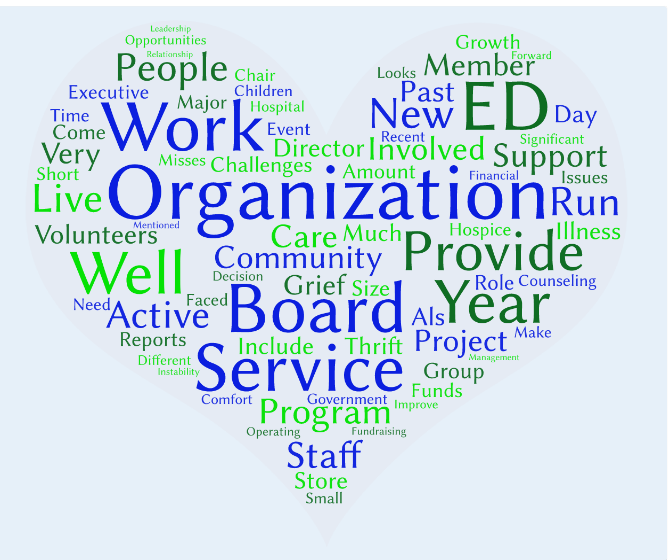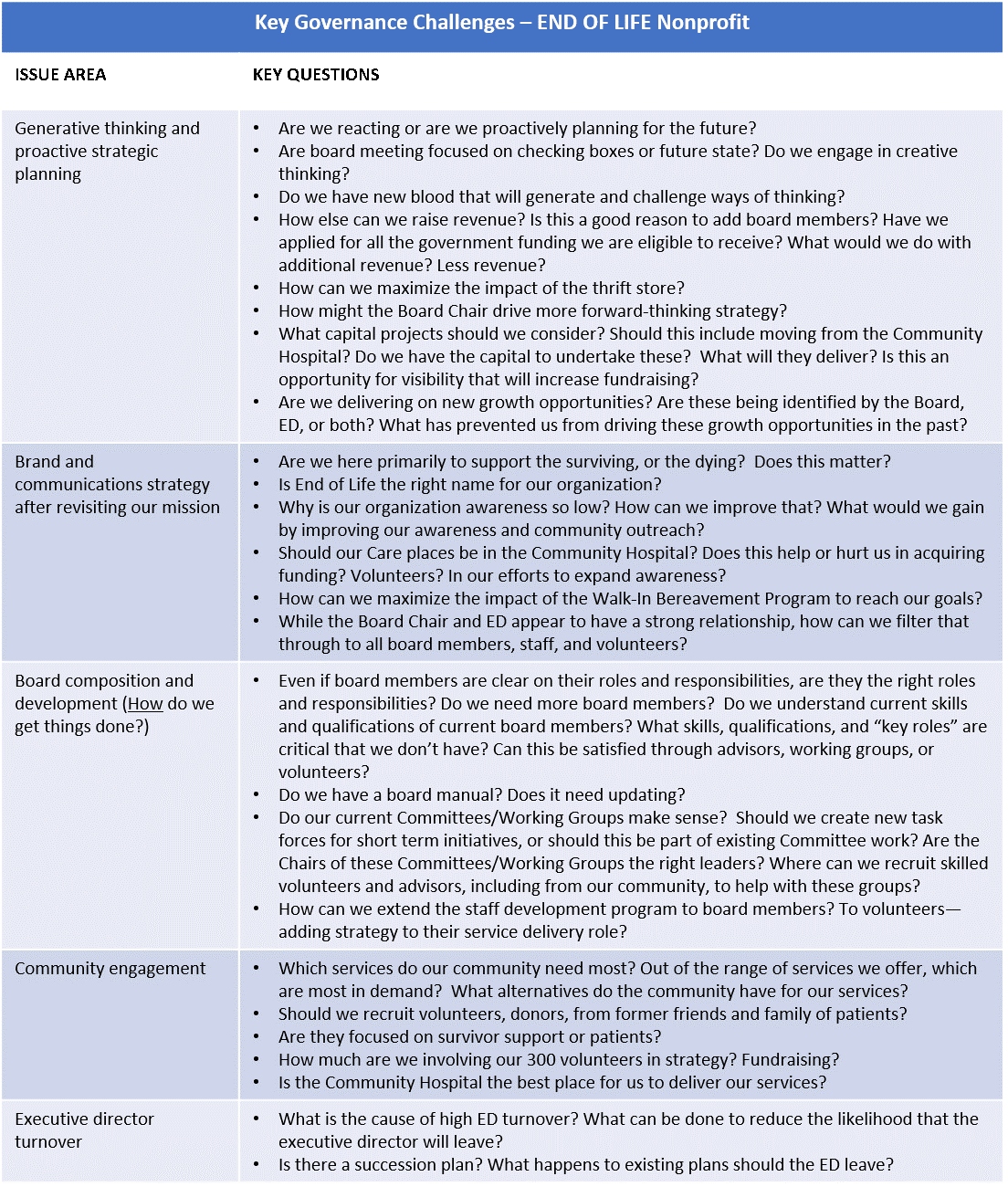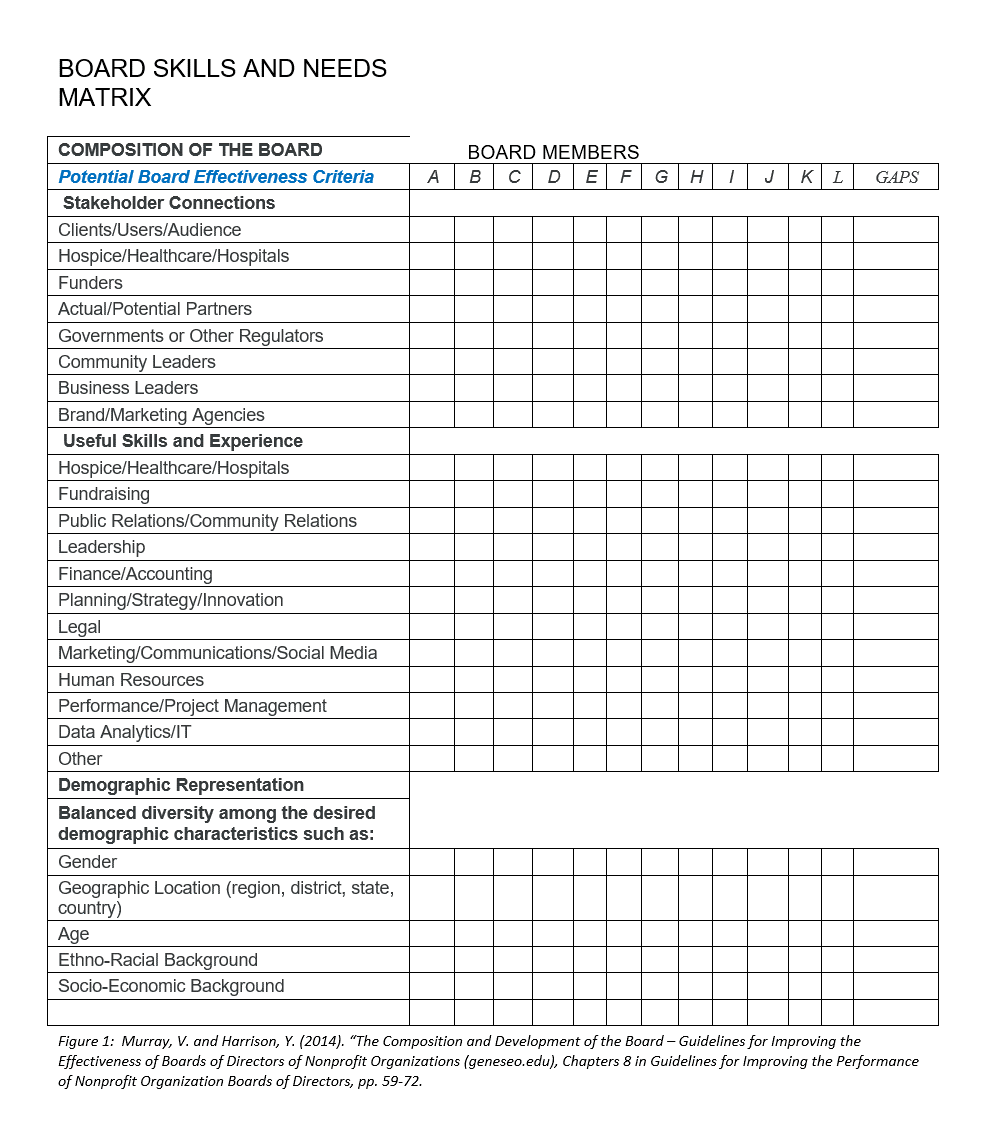Resuscitating Board Effectiveness for End of Life Nonprofit
Resuscitating Board Effectiveness for End of Life Nonprofit
Barbara R. Ryan
Coursera: University at Buffalo & The State University of New York
The Factors that Influence the Effectiveness of Boards and the Governance Process
Part of Coursera Specialization: Developing Leadership and Improving Governance in Nonprofit Organizations
Professors Yvonne Harrison and Vic Murray and the Instructional Team
Submitted 9 January 2021; Due date 25 January 2021
Abstract
The board of the End of Life Hospice organization has just completed a self-assessment check-up. This paper represents the content of a Special Board Meeting at the kick-off of a weekend Board Weekend Retreat, to present the results and analysis of the check-up plus recommendations to the board and executive director (ED). Also present at the Special Board Meeting are all 9 employees of End of Life, top donors, and representatives from the 300 volunteers and working groups that support the organization. The presentation is delivered by a third-party consultant, who acted as Project Coordinator for the assessment, working with the Nominating and Governance Committee and representatives from the working groups.
Keywords: board composition, boards of directors, board effectiveness, board performance, board self-assessment, board size, branding and communications, community engagement, community hospital, end of life, executive director, fundraising, generative thinking, governance, grief counseling, hospice, leadership, mission, nonprofit organizations, skills matrix, strategic planning, survivor, task force, thrift store, turnover, work groups.
Special Board Meeting: End of Life Board Assessment Results and Recommendations
Good morning, Mr. Chairman, members of the board, Ms. Executive Director, and attendees from End of Life. In response to key challenges and opportunities the End of Life organization is facing, last month, our board members received a self-assessment about board effectiveness. Today, along with the Nominating and Governance Committee and representatives from the working groups, I’m here to present our findings, analysis, and recommendations for improving board effectiveness and performance. I’m an independent consultant from 911 Board Consulting.
It’s important to note that the purpose of the assessment is not to bemoan the past, but to seek ways improve the board’s effectiveness, and thereby, performance by End of Life, and to have all the key stakeholders together to learn and discuss opportunities for us, the organization and the people we serve.
The purpose of today’s meeting is to agree which issues we should focus on, and then identify possible solutions. It will also be to name a Working Group to return with recommendations for change.
The agenda for today’s meeting is:
Board Effectiveness Assessment Results
Understanding Results
We received an 80% response rate on the board self-assessment which covered 9 board effectiveness dimensions. It’s important to note that a red (low score) rating also includes respondents who answered “not sure.” Also, due to the different number of questions in each dimension, results displayed have been standardized to the same scale for comparison.
Check-up Results
For the nine dimensions assessed, we found that the high level structure and operating procedures of board itself and organization by the Chair were strengths. The areas needing further exploration were the composition of the board, onboarding and orientation of new board members, roles and responsibilities, and fundraising. At first glance, it appears that how the board collaborates to achieve its mission is central to organizational improvement.

How Results Compare with Other Nonprofit Boards
The dimensions that were noted as most problematic, the board’s role in fundraising and composition and development of the board, are frequently cited by nonprofit boards as leading issues. In a study self-assessments of 1446 individuals from 122 organizations through www.boardcheckup.com website, fundraising, new members, and ongoing development were ranked as most problematic.1 In a Boardsource.org self-assessment report, board composition, culture and funding were ranked greatest areas for concern.2
Top 5 governance strengths and top 5 governance challenges
In addition to the self-assessment scoring, we considered collected verbatim from the board, executives, volunteers and working groups. We looked at frequency of mention, producing a word cloud to visualize this, along with considering the context of language used.

Looking at the word cloud, we might consider:
- Are “volunteers” and “community” not in the forefront as much as they should be, considering volunteers provide most services and there are only 9 employees?
- Where is the emphasis on the people to whom we provide services: patients and their supporters (the survivors)?
- Are we focused too much on the “work” of the board, rather than our future mission for the organization and the people it serves?
Analyzing the additional verbatim in context, these are the top 10 governance strengths grouped into five key areas identified for End of Life:
- Board Leadership and Structures are Sound. Engagement is high with meetings well attended. Positive relationship between the ED and Board Chair. Separation of board and executive responsibilities. Meetings are well structured.
- New Opportunities for Growth Identified, albeit driven by the ED.
- Volunteer and Community Engagement. 300 volunteers in their base, providing primarily service delivery. Community Hospital support.
- Sound Financials and Fundraising Endeavors, including a thrift store. The organization’s finances are in good order.
- Continual Board Assessment. Awareness of board weaknesses and opportunities.
Key issues challenging board effectiveness
These were identified and grouped into five key governance challenges and associated questions we might ask when considering areas for improvement:

While a first glance at the results indicate approval of the board structure, structure, roles and responsibilities are not clear to the members. Doubt over existence of an up-to-date manual, limited structure around volunteer and community participation, strategic plans that are mostly determined by the executive director, weak engagement by board members in fundraising, and problem-solving over leadership are areas for improvement.
Practices and Recommendations
When it comes to impact on organizational performance, according to BoardSource, “chief executives and board chairs agree…that two particular board characteristics matter most: the board’s understanding of its roles and responsibilities, and the board’s ability to work as a collaborative team toward shared goals.”3 We believe that the main challenges of the board are rooted in clarity around roles and responsibilities (e.g., its responsibility to lead change over addressing problems) and the ability to work as a collaborative team, not only among itself, but among its community, volunteers and staff (e.g., leading to redefining its mission based upon the primary market it serves and their needs).
Now we’ll review some of the key challenges and suggested practices that can be employed to answer the questions surrounding those key challenges.
“Instead of identifying problems, most boards address the problems that managers present to them.” CThe End of Life board of directors needs to shift focus from addressing problems to reverting to the past to readdress “what is our mission.” Times have changed and so have the community’s needs. We used to think of our customer as the hospice patient, but our primary customer is his or her family and friends – the survivors and former caregivers. They have ongoing needs of emotional support, have suffered the experience of losing a loved one, and represent opportunities for End of Life to grow. They not only become our volunteers, whom we are dependent upon for delivery of our services, they are also most likely to become our biggest donors and provide referrals.
In short, two of the key challenges have the same root. Our mission and branding are derived from how we collaborate and “think” as a board. Dr. Laura Schweitzer, Vice President of Health Sciences and Biomedical Initiatives at the University in Albany, encourages boards to focus on “revisiting the mission, because the board really does define the mission…and making sure periodically that your mission is up to date is really important.” 5
We recommend starting at the beginning by creating a working group for branding and communications, which also includes revisiting our mission. If we are called “End of Life,” we are targeting our former primary target market, not today’s. We need to rethink what services our survivors need and want, and the competitive landscape and trends. We recommend research to assess the greatest needs to realign our mission, branding and communications. We encourage the board to allot 20 minutes of each board meeting for generative thinking to find creative, new approaches to our business.
The question is really about overall composition of the board. The board should not change the size of the board based solely on the size of the board. “Many small boards want to be larger in order to raise money…. Trustees and managers are convinced that board size significantly influences board performance, but we have seen boards of all sizes that are effective and ineffective, engaged and disengaged, incredibly valuable or nearly worthless.” 6 In fact, studies indicate that there is no relationship between board size and performance. 7
In order to determine if we should recruit new board members because we need fundraising and communications experts, we first need to know if we already have those unidentified skills and qualifications on the existing board, what other essential skills and qualifications the board lacks, if these gaps can be fulfilled through volunteers or advisors, what issues we might create by adding new members, and whether issues will be resolved through adding board members.
“According to the most recent edition of Leading with Intent, fundraising tops the list of board challenges,” 8 while it also has one of the poorest ratings for board performance. But rather than recruit new board members, an alternative can be to get “all board members involved in its various activities, such as…working with the chief executive on a successful strategy.”9 While the ED has proposed several growth opportunities, these will require funding beyond today’s budget of about $500,000 per year. Our recommendation is that we start by substituting the word “fundraising” with “revenue generation” and use generative, creative thinking to find new ways to generate revenue, beyond donor expectations, including those from new board members. These could be as broad as an ecommerce platform for our successful thrift store, memorial merchandise and retreats for loved ones who have passed to re-engage survivors, premium paid optional services for those in hospice care include those that may be supplied by small businesses in the community, etc. We’d like to establish a working group to drive new revenue opportunities for the organization.
We recommend using a skills matrix to determine skills and gaps, and to use for recruitment of new board members, if board gaps are determined, similar to the one below. If there are critical gaps, the board should move forward with recruiting new members.

With respect to bringing on new board members to bring in fresh ideas, we should consider whether other board members should be retired. After the results of the skills matrix are available, a discussion on term limits will be added to the agenda for the Nominating and Governance Committee meeting.
Today is the kickoff of our retreat. This is an opportunity for the current members of the board to participate in a weekend of activities to improve how we collaborate and lead. For new board members, we recommend creating “a formal orientation program at which new board members meet top management officials, tour facilities and hear presentations on the organization’s programs and background information on strategic issues,” as well as “informal “mentoring” programs.
We recommend updating the board manual, and clearing defining the following:
- board roles and responsibilities
- executive director roles and responsibilities
- survey on current and former ED
- retention and succession strategy for executive directors
- working groups/committees’ roles (including chairs) and responsibilities
- guidelines for working with volunteers, staff, and the community
Prioritization and timeline of recommended changes
Realigning roles and responsibilities and generative thinking, starting with revisiting the mission statement have been prioritized, since all other priorities and initiatives are reliant on them. “The board’s understanding of roles and responsibilities is fundamental to the board’s performance across the other areas of board responsibility….boards that have a strong understanding of roles also tend to have stronger performance across all other performance areas.10

Review of Keywords: board composition, boards of directors, board effectiveness, board performance, board self-assessment, board size, branding and communications, community engagement, community hospital, end of life, executive director, fundraising, generative thinking, governance, grief counseling, hospice, leadership, mission, nonprofit organizations, skills matrix, strategic planning, survivor, task force, thrift store, turnover, work groups.
Below we’ve listed the timeline of recommended changes. The Chair of the Nominating and Governance Committee/Working Group will be tracking progress and reporting at board meetings, as well as tracking improvements against next year’s board self-assessment.
Discussion
We’d now like to open the floor to discussion on the recommendations. Would the Chair request a motion to open the discussion?
References
- Harrison, Y.D. and Murray, V. (2014). The Effect of an Online Self-Assessment Tool on Nonprofit Board Performance, Nonprofit and Voluntary Sector Quarterly.
- BoardSource. (2018). Revised 2018 BSA - Governing Boards – SAMPLE. BoardSource. Retrieved from https://boardsource.org/wp-content/uploads/2019/10/BSA-Sample-Report-2019-10.4.19.pdf
- BoardSource. (2017). Leading with Intent: 2017 National Index of Board Practices, Washington, D.C.: BoardSource. Retrieved from leadingwithintent.org.
- Chait, et al. (2005). "Type III: Generative Thinking", Chapter 5 in Governance as Leadership, Hoboken: John Wiley and Sons, pp. 93-94.
- Murray, Vic. and Harrison, Yvonne. Course: The Factors that Influence the Effectiveness of Boards and the Governance Process. University at Buffalo & The State University of New York Interview with Dr. Laura Schweitzer: Leadership and Governance of Nonprofit Organizations from a Practitioner Perspective
- Chait, R. Ryan, W. and Taylor, B. (2005). "Where to Next,” Chapter 8 in Governance as Leadership, Hoboken: John Wiley and Sons, p. 175.
- The Nonprofit Quarterly, Special Governance Issue: Emerging Forms of Nonprofit Governance, Winter 2012. Reference: Ostrower, Francie. (2007). Nonprofit Governance in the United States: Findings on Performance and Accountability from the First National Representative Study (Washington, DC: Urban Institute Center on Nonprofits and Philanthropy), www.urban.org/publications/411479 .html.
- BoardSource. Leading with Intent.
- Murray, V. and Harrison, Y. (2014). The Composition and Development of the Board – Guidelines for Improving the Effectiveness of Boards of Directors of Nonprofit Organizations (geneseo.edu), Chapter 8 in Guidelines for Improving the Performance of Nonprofit Organization Boards of Directors, pp. 59-72.
- BoardSource. Leading with Intent, p. 47.